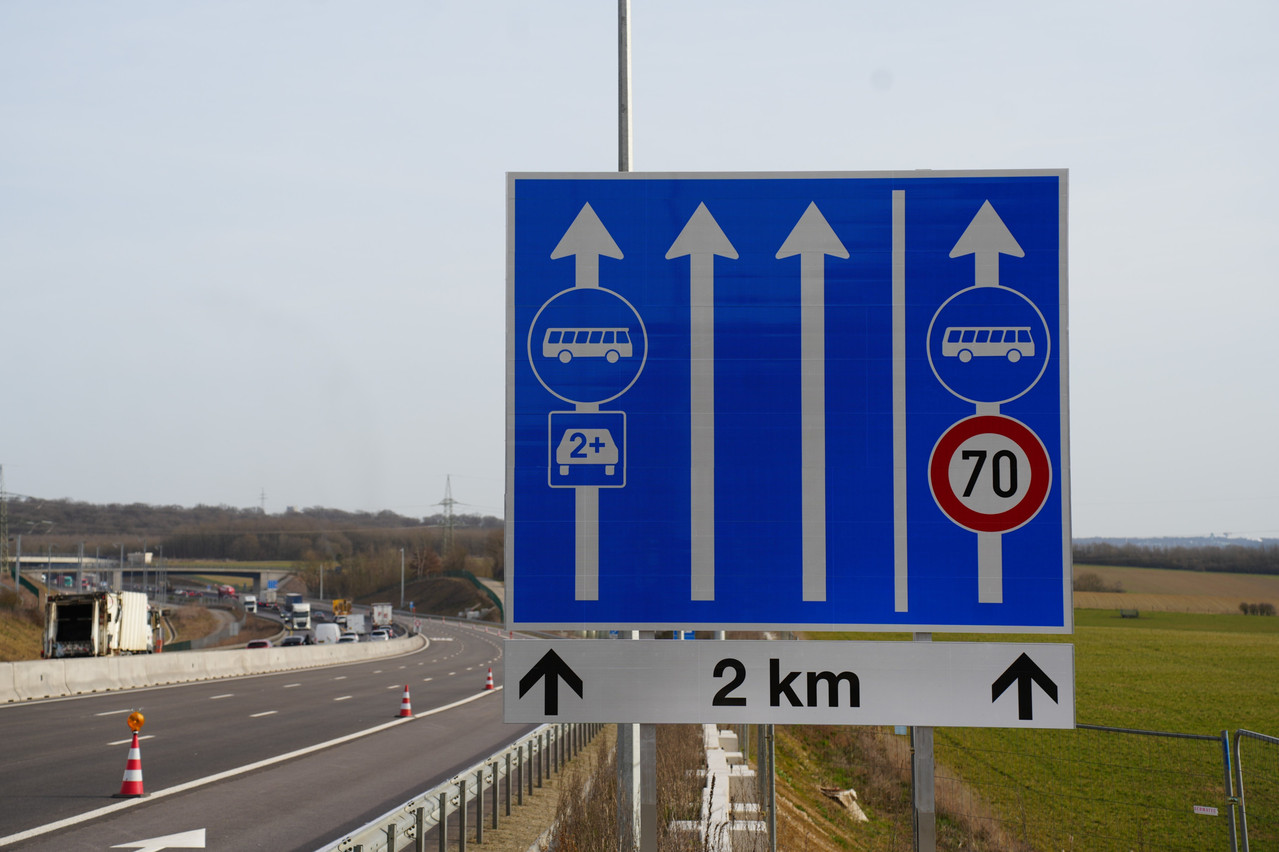A carpool and bus priority lane--operational 24 hours a day--has recently been installed on the A3 motorway, over 2.1km-stretch between the Berchem service area and the Croix de Gasperich. At the end of this section, this left-hand lane becomes a normal traffic lane. Another lane, on the right at the hard shoulder, is reserved for buses. The speed limit on these two specific lanes is 70 km/h during rush hour.
Designed to improve traffic flow and encourage carpooling, the system may come as a surprise, with not one but two reserved lanes. But also because, in other cases--such as a few kilometres from Luxembourg, between Arlon and Sterpenich--the lanes reserved for carpooling are more often than not located on the right.
This Luxembourg configuration has a logic, however: the aim is to avoid conflicts with motorway entrances and exits (which are on the right) and to keep the lane fluid to avoid slowing down.
Despite the signage put in place, the operation did not always seem very clear, to judge by some of the behaviour observed on this stretch of motorway, with single motorists travelling in this lane, and cars with two or more passengers in the central lanes.
However, this special lane is the subject of several signs: on the ground, as well as via signs placed three kilometres and 600 metres from the start of the lane. Blue in colour, these signs show a car accompanied by the words “2+”.
Note, however, that drivers of car-sharing vehicles are not obliged to use this dedicated lane.
Zero tolerance
Although the scheme is still in its infancy, Luxembourg’s mobility ministry wants to enforce the rules now. A lone driver using this lane “is liable to a minimum fine of €74. There is no tolerance applied. The carpool lane is reserved for vehicles occupied by at least two people and for buses,” the ministry points out. In order to monitor the proper use of this lane, the ministry mentions two phases. “In the first phase, use of the lane will be monitored by police patrols. In the second phase, it is planned to install field equipment to monitor the use of the lane and punish offences.” However, it does not give any further details on the type of system envisaged.
There are a number of ways, both technological and human, to monitor the proper use of the road. In Lyon and Strasbourg, experiments have been carried out using intelligent cameras with optical recognition, which use AI to detect the number of occupants on board, but their reliability varies depending on a number of factors, such as luminosity or the tint of the vehicle’s windows. Thermal cameras can also be used, but the costs are generally higher the technology is less advanced.
And on the insurance side?
Beyond the fine or penalty, there is also the question of the damage that would occur. Let’s take the example of a lone driver who is not allowed to use this lane and who causes an accident. Would they be covered by their insurance? “It depends on the insurance policy,” replies the mobility ministry.
This is confirmed by Brucher Thieltgen & Partners’ senior associate , an insurance and liability lawyer practising in Luxembourg and Belgium, who provides some clarification. “We need to distinguish between two relationships: on the one hand, the relationship between the insurer and the injured party; and on the other, the relationship between the insurer and its own policyholder (the driver at fault). In the first relationship, the victim will almost certainly be compensated by the insurer of the driver at fault. In the second relationship, driver is not immune from his insurer refusing to intervene for material damage to his own vehicle,” Nicolas points out, adding that “everything depends on the case in question and the content of the insurance contract.”
However, this type of behaviour is unlikely to be very clearly and precisely defined in the contract, as this is a very specific case and insurers work with relatively standard policies.
Luxembourg’s Insurance Companies Association (Aca), which was also approached on this subject, adds: “For this type of offence and in the event of an accident, there is no exclusion of cover or recourse against the driver at fault. The claim will be covered by the insurer to compensate the victim of the accident under motor third-party liability insurance, as well as any damage to the vehicle at fault if it is insured for material damage.” The association notes, “We would, however, like to reiterate the importance of careful driving for obvious road safety reasons, and also in terms of the insurance contract, since an at-fault claim will have consequences for the driver’s bonus/malus.”
This article was originally published in .
